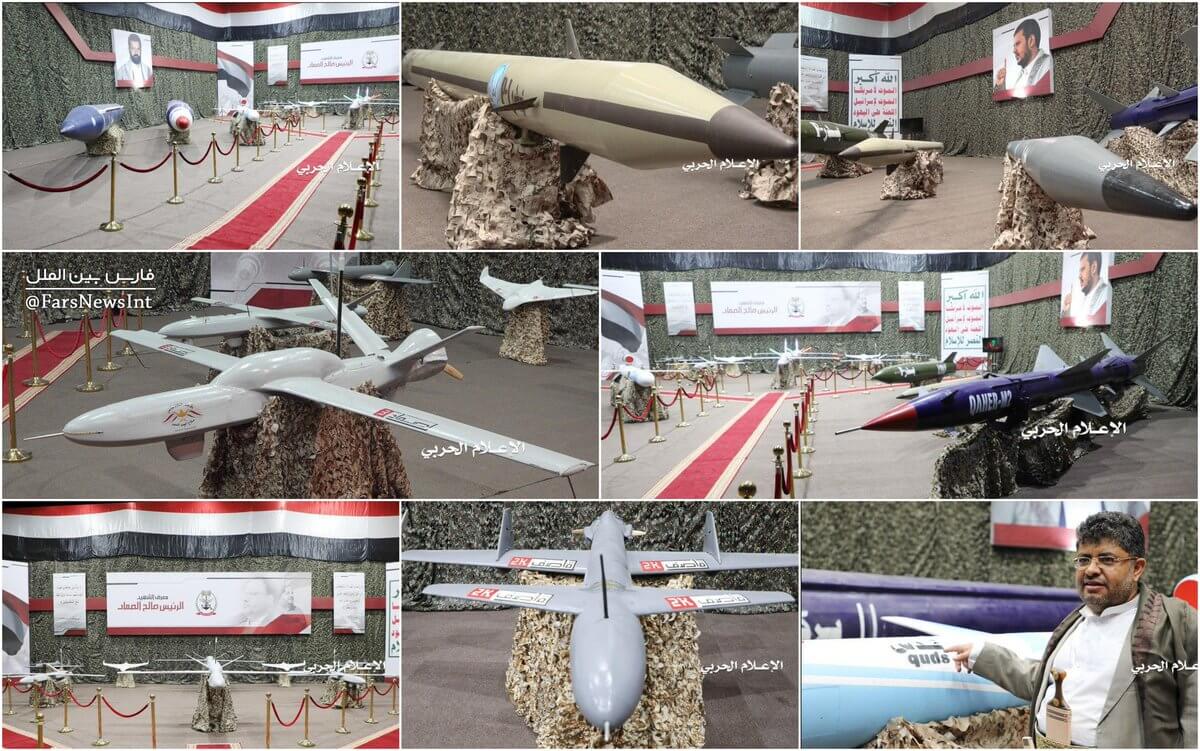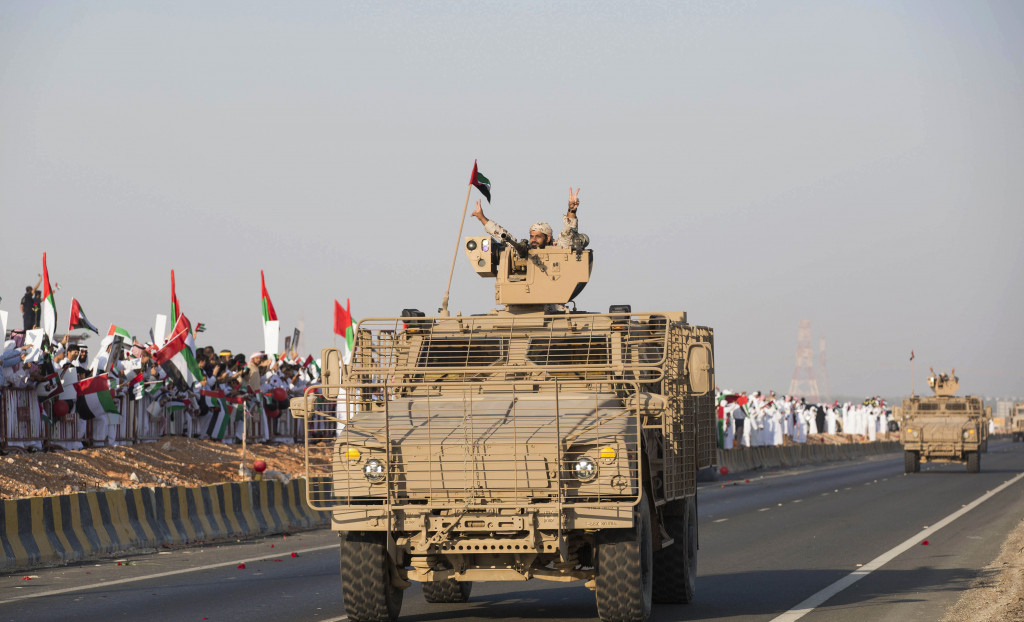SANA’A, YEMEN — Yemen’s Houthi-allied armed forces have unveiled a package of new domestically-manufactured military hardware, including ballistic and winged missiles and drones. The weapons were unveiled in the Yemeni capital city of Sana’a on Sunday afternoon during an exhibition named after Saleh al-Samad, the president of Yemen’s Supreme Political Council, who was killed in a targeted Saudi airstrike in Hodeida in April 2018. The unveiling of the weapons comes as the United Arab Emirates (UAE) announced it would begin withdrawing troops from Yemen, confirming that the Houthi strategy of striking Saudi-led Coalition targets on their own territory has succeeded in acting as a deterrent.
On Tuesday, the media bureau of Yemen’s Operations Command Center displayed the Samad 3 reconnaissance drone and the Qasef 2K drone, both of which had not been previously publicly displayed. Both the Samad 3 and the Qasef 2k have been used to hit vital targets in Saudi Arabia and the UAE. The drones were used to strike the Abu Dhabi Airport and Dubai Airport, as well as in several other recent drone and missile attacks targeting Saudi Arabia’s southern regions of Khamis Mushait and Jizan.
According to a statement by the Yemeni army issued on Tuesday, the Samad 1 is capable of flying over 500 km and has the ability to monitor targets directly and relay that data back to an operations room. The army statement placed the range of the Samad 3 at 1,500 to 1,700 km and said it was equipped with advanced technology that would render it difficult for air defense systems to detect.

The Samad 3 is laden with explosives that allow it to detonate a shaped charge which explodes downwards towards its target. Footage provided to MintPress by Yemen’s Operations Command Center shows the Samad landing on an asphalt runway, confirming that the drone is now capable of conducting operations and then returning to base.
Sunday’s exhibition — which was opened by Mahdi al-Mashat, the Head of the Supreme Revolutionary Committee of Houthis — also included the Quds 1 winged missile, which was used in an attack on the Barakah nuclear power station in Abu Dhabi, the capital of the UAE, in December 2017. The UAE denied that an attack on the power station ever took place.
Brigadier General Yahya Saree, the spokesman for the Sana’a-based Yemeni Armed Forces, said during a press conference in the capital on Tuesday that there are several generations of Quds 1 winged missile still undergoing development. “The Quds system proved its great ability to hit its targets and to bypass enemy interceptor systems.” Saree said. On June 12, the Saudi-led Coalition confirmed that Houthi forces had fired a “projectile” at the Abha Airport in southwestern Saudi Arabia, roughly 100 miles from the Yemeni border, claiming it had killed one person and injured nearly 30.

The Yemen army’s exhibition also included the Borkan (Volcano) H-1 and H-2. The Borkan is a modified Scud and was used in a strike on the King Khalid International Airport near Riyadh, more than 800 km from Yemen’s northern border. The missile was able to evade U.S. Patriot missile air-defense systems. A high-ranking Yemeni official, who spoke on the condition of anonymity, told MintPress News that Yemeni forces have manufactured a new version of the Borkan that will be revealed in the next few days. The coming iteration will be able to hit targets even farther than the previous versions used in strikes on Saudi Arabia and the UAE.
Yemen’s Houthis and the allied Yemeni Armed Forces have been increasing the production and use of domestic drones and ballistic missiles in recent months, as UN-backed peace talks with the Saudi-led Coalition have failed and Saudi airstrikes continue to hit schools, hospitals and wedding parties, killing thousands of Yemeni civilians.
The Houthis hope that by striking the Saudi-led Coalition on its own territory, they can deter the deadly attacks on Yemen that have been ongoing since 2015 when the Coalition began its air campaign. The strategy appears to be working, as Saudi Arabia’s main partner in its war on Yemen, the UAE, recently announced it would begin a drawdown of troops from the country.
UAE withdrawal follows credible threat of Dubai attack
The announcement from the UAE came after Houthi leader Abdulmalik al-Houthi threatened to target vital objectives in Dubai if the UAE continued its involvement in the war against Yemen, according to a statement by a high-ranking source allied with the Saudi-led Coalition, who asked to remain anonymous.
On Monday, an unnamed UAE official told the Emirates News Agency that the Gulf state had already pulled out some of its forces from areas including the southern port of Aden and the western coast. A local source also told MintPress that the UAE has totally vacated its military bases in Khokha, about 130 km south of Hodeida, and Sarwah near Marib province. A Yemeni military official told MintPress that any withdrawal would not hinder the UAE’s long-term ambitions to control Yemen’s ports and resources.

For their part, the Houthis have called for the full withdrawal of all Saudi-led Coalition troops from Yemen. Mohammed Ali al-Houthi, a high-ranking official in the Houthi movement, tweeted on Monday: “Withdrawing from Yemen is the ideal decision that must be taken at this time.”
Al-Houthi followed Monday’s tweet with another on Tuesday that went even further:
We call on the countries of aggression to announce their withdrawal from Yemen, as the Republic of Yemen rejects the aggression, siege, and embargo…
It is enough that the countries of aggression have used Yemen as a testing field for European and American weapons for the past five years and proved the ugliness of their criminality to the world.”
In reality, the UAE’s involvement in Yemen is far from over. If a full military withdrawal does not occur, the UAE will resume its goal to control strategic ports, islands and other locations across Yemen, but instead of relying on its military it will likely employ paid mercenaries to secure its interests. “We are not worried about a vacuum in Yemen, because we have trained a total of 90,000 Yemeni forces,” an unnamed UAE official was quoted as saying on Monday, referring to the myriad of armed Yemeni tribal groups that are armed and funded by the UAE.
Feature photo | An exhibition in Yemen’s capital city of Sana’a shows a variety of the Houthi’s domestically manufactured drones. Photo | AMC
Ahmed AbdulKareem is a Yemeni journalist. He covers the war in Yemen for MintPress News as well as local Yemeni media.


